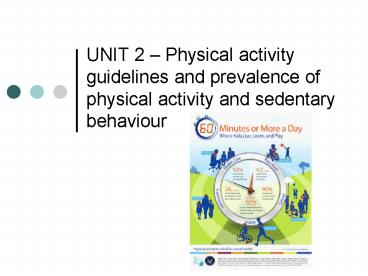UNIT 2 PowerPoint PPT Presentation
Title: UNIT 2
1
UNIT 2 Physical activity guidelines and
prevalence of physical activity and sedentary
behaviour
2
Key knowledge
- The dimensions of the Australian National
Physical Activity Guidelines for all stages of
the lifespan - Current levels of physical activity and sedentary
behaviour in Australia
3
Key skills
- Describe the National Physical Activity
Guidelines across the lifespan and assess the
adherence to these guidelines - Collect, analyse and interpret data relating to
the current levels of physical activity and
sedentary behaviour in Australia
4
OVERVIEW
5
National Physical Activity Guidelines
- Within developed countries an important role of
governments is to set national physical activity
guidelines - By the 90s it was recognised that only a small
proportion of the population were meeting fitness
based guidelines - A report in 1996 recommended that significant
health gains could be obtained from engaging in
moderate intensity physical activity on most
days of the week
6
Adults
- The National Physical Activity Guidelines are a
minimum recommendation for good health (compared
to the demands of an athlete) - The guidelines encourage all forms of movement
including moderate intensity activity - The guidelines also include the benefit of
vigorous intensity physical activity - These guidelines should be combined with a
healthy eating plan
7
Young children
- Children under 5 tend to be spontaneous in their
forms of physical activity - Research shows that active play assists children
to develop muscles, bones and the heart,
fundamental motor skills and communication and
social skills - Exploration through play should allow children to
build things, climb, run, dance, jump, hop and
use their imagination
8
Young children
- Young children should have opportunities to
accumulate physical activity through - Unstructured free play sand pit, dress ups
- Structured play creative movement classes
- Active transport scooter, bicycle
- Everyday physical tasks helping with gardening,
meals or picking up toys
9
Children and youth
- Children 5-12 years old (primary aged)
- Youth 12-18 years old (secondary aged)
- Children and youth should participate in a range
of different types of physical activity - This should include weightbearing impact-type
activities (skipping, jogging, hopping, jumping,
etc) which are important for bone health - This guideline targets free time as times of
sedentary behaviour are unavoidable due to the
constraints of homework at a youth age
10
Older people
- All older people are encouraged to do some form
of physical activity regardless of health or
fitness levels - Forms of fitness should incorporate strength,
balance and flexibility - 30 minutes of moderate-intensity physical
activity on most, and preferably all days is
recommended - This will assist in preventing issues associated
with aging
11
Overweight or obese people
- It is recommended that overweight or obese people
engage in 60 minutes of physical activity per day - Once the weight has been lost this should
increase to 60-90 minutes of activity per day to
avoid weight gain
12
(No Transcript)
13
(No Transcript)
14
Thinking it through
- What are the physical activity recommendations
for healthy weight adults? - Describe the recommendations for adults that
encourages vigorous physical activity - Identify five important types of physical
activity for 0-5 year olds. Select one of these
and provide some specific examples - Outline the recommendations relating to screen
time for a 2-3 year old

